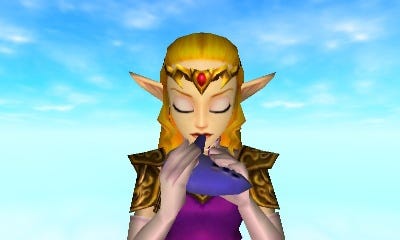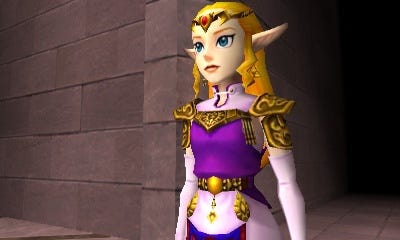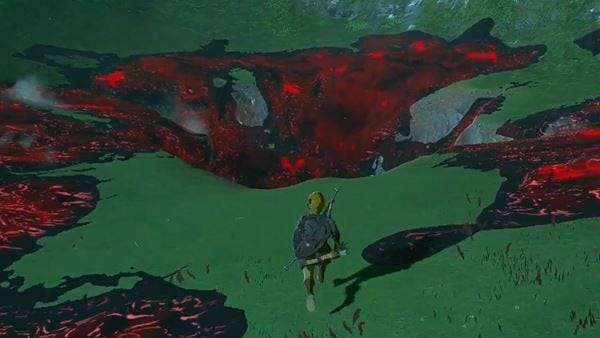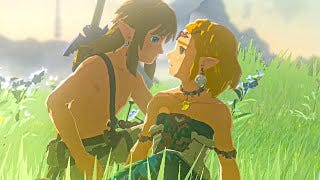SPOILER WARNING for Legend of Zelda: Tears of the Kingdom. Also Ocarina of Time? But I think we’ve hit the statute of limitations there.
I spent the summer of 1999 in the lake house. It was quiet there, especially compared to the surrounding forests and canyons, plagued by bad weather and unwelcome creatures. Most afternoons were spent perfecting my cast into the fishing hole, learning to walk slow around its edges and developing an eye for the shadow of the legendary Hylian Loach. I’d watch the sun change in the sky and turn the water gold, sometimes doing nothing at all but taking in the way light rearranged the world right before my eyes.
Nintendo didn’t actually program a house for Link into The Legend of Zelda: Ocarina of Time’s Lake Hylia. Not like they did in its great-great-great-great-great-grandchild, Tears of the Kingdom. Like so much in that much earlier game, I shaded it in with my imagination. The same way my mind smoothed out the jagged peaks of Death Mountain into round hills and Zelda’s solid chunk of blonde into soft, gently waving hair that framed her face into the most beautiful princess I’d ever seen. I stitched together who loved or hurt or longed for who between the vague and sparse dialogue boxes. I explored every last seam and nook within it for secrets or surprises left by its creators and, as they grew scarce, made up my own.
There is much less left to imagine in the ambitious Tears of the Kingdom, released 25 years after its predecessor. And for me, now 25 years older, there is far less time and hunger to uncover it. In fact, I know that I shouldn’t be playing this game at all. The Reels in my feed (yes, because I watch TikToks on Facebook like a proper Old) of kids the same age that I was when I first visited Hyrule building giant laser beam hovercrafts and doing shield surf tricks down mine rails speak the truth–this isn’t for you. I have a full-time job, and a spouse and a small child, and a house and yard with maintenance fetishes. I should be watching The Bear.
And yet. I have stolen the time. Hour by hour, after dinners and before pushed bedtimes. Three hundred and fifty of them, my Nintendo Switch account gleefully records. After a lifetime of barely touching a Zelda game, I cannot put it down. I’ve burrowed deep into the Lake House, hiding from the fall.
I wish I had a better recollection of getting my hands on a copy of The Legend of Zelda: Tears of the Kingdom the weekend it was released. Maybe because there is no “get a copy” any longer; there is no drive to GameStop, no weight of the metallic cardboard box in your hands, no flipping through the glossy guide with dreamy descriptions or elegantly rendered maps or artist’s character renderings. There is only smashing the Buy button on the Store screen, an action I may have taken in any combination of drunk or bored or wistful stupors. All I know is that over that first weekend in mid-May, I was tugged into Princess Zelda and her swordsman/fall guy Link’s kingdom of Hyrule in a way I hadn’t been by any other game since that now classic, vintage game of my youth.
For those who have not let this game infect your life, this version springs from the same lore that was established in 1986 with the release of The Legend of Zelda on Nintendo’s original home console system. There is Princess Zelda, who rules over Hyrule. There is Ganondorf, the invading villain who shifts between man and monster throughout the franchise. There is Link, the character you control, who emerges from different variants of nowheresville to become the kingdom’s greatest warrior and savior.
Tears is a direct sequel to 2017’s Breath of the Wild, a game I entertained for about 20 minutes before my only weapon broke, and I had my ass handed to me by a team of piggish goblins. It opens with Link and Zelda a short time after the previous game ended, investigating a strange phenomenon of a creeping mist they’ve dubbed “gloom” rising from the foundational bowels of the castle; a place so deep and dark, it’s been all but forgotten for centuries. The evil they discover further down the passage tears the entire castle off its foundation in a cloud of all-encompassing gloom, and opens gaping chasms throughout the land that spew darkness and lead into a second kingdom called “the Depths,” mirroring the land of the living and hiding ancient, forgotten secrets.
There are plenty of monsters in the game, but the true terrors are those lost battles and forgotten hurts, folded over in the churn of seasons and sunrises on the surfaces but still here, somehow, down below, in this place where light does not shine. The chasms blemish the rolling landscape sending up flares of blood-red “gloom” that has ceased to be contained by the land above.
There is something visceral about the memories we uncover; those accidental recollections where a former self is triggered in the glass reflection. The scenes we’ve buried that play again uninvited, sending our souls recoiling with humiliation and regret. “The foulest stench is in the air/the funk of forty thousand years,” Vincent Price will start reminding us next month in the grip of Spooky SZN.
That is why this sunken place terrorizes my imagination in the way a dragon or a monster couldn’t possibly.
So many of the years between this game and the other I spent opening myself up as a writer and artist, unpacking who I was within the world. I would dive head-first into the blooming, festering chasms I could feel puckering at my skin and thrust whatever I found into the light, turning it and running it up against other shards I’ve gathered up, the satisfying click when the narrative fit like a puzzle. It’s been recent, this question of my sanity with this impulse, the new voice chanting why are you doing this, warning me not to claw in too deep. I might not like what I find.
The consequences in Ocarina of Time felt brief and reversible—people had made mistakes, underestimated the prevalence and allure of evil, but in the stretch of one boy’s coming-of-age, the world could be fixed. The evil could be sealed, and peace could be realized.
The Hyrule of the 2020s is as doomed as the civilization crumbling from its sky, raining a vaporized empire down on a dying one, teetering on the corpse of every iteration before it. The follies of the past are inescapable here, and yet its residents—the one without a touch of destiny—continue on as best as they can. They tend to their horses and their schoolchildren, get angry about elections, shake their head at the latest newspaper that reads like fiction. Above the horizon, Hyrule Castle, the seat of the crown, hovers ablaze with evil possession. And yet, what can they do? We are here to save them, and yet there is an unspoken arrangement between these innocent bystanders and Link the avatar. There was a Link and Zelda before you, and there will be Links and Zeldas after you. You save the world only long enough for it to be corrupted once again. We have long stopped believing in happily ever afters.
The lives of the Hylians, despite all pointy ears and magic wells to the contrary, are utterly relatable. It’s the benevolent boy in green who is the fantasy.
This is, after all, the twenty-twenties. We raise our eyes up to assess how blotted our sky will be by the ashes of our surroundings. “When the blood red moon shiiiines across the laaaand,” my almost-4-year-old daughter narrates, imitating Zelda’s monologue when wildfires create a crimson sunrise. This is the only world she knows.
Is she the blessed one, the one with no context on what the world was like before our castles were razed?
As much as I adored putting around the placid nooks of Hyrule for hours that last summer of the 20th century, I was just as happy plunging back into the final fight. In Ocarina of Time you fought your way up a red velvet staircase snaking the evil castle, where Ganondorf waits in his stained-glass tower plunking away on his menacing pipe organ (and positively nailing the vibe). It was a satanic chapel, markedly evil but a place of-this-world. It made his defeat feel tangible and possible because it was set somewhere familiar. You could imagine Princess Zelda returning after the final fight with her design team, taking a deep breath and rolling up her sleeves to set things right… The gargoyles are going to have to go, but you don’t find this kind of lead-and-glass craftsmanship just anywhere nowadays. Does anyone know if the Temple of Time would take a decommissioned organ…?
I put off confronting my adulthood incarnation of Ganondorf for weeks after I could have done so, following the game’s vaguely linear structure. I gathered the healing Sundelion flowers from the sky and upgraded everything with fairy magic, my overprepping anxiety manifesting even in this dream world. I dawdled around, seeking out caves and extraneous items like the frostbite pants. Until finally, the anxiety of the looming dread won out against my hesitance.
In this game, the fight descends, an unnatural mechanic that knits another layer of dread on top of the eerie music crescendo and thickening gloom. You fall so deep, you lose your friends and companions, unable to reach you as evil scrambles reality. The loneliness is palpable; there’s no indication when or if they’ll be back.
I breathed deep. I took another shot. I felt my heart hammer in my chest, as if the gloom was fizzing beneath my own home’s foundation.
In the end, the specter of the Demon King wasn’t the stuff that will linger in my nightmares. Not like the dark itself, and what your imagination conjures in place of what’s festering unseen. And the ending, after hacking through the villain with my best cutlery, revealed Nintendo’s desire to cushion all of that carefully crafted discomfort blooming from a summer spent in this doomed Hyrule. One of the game’s biggest plot reveals was that Princess Zelda, after being transported a millennium back into the past, discovered that the only way she could deliver the Master Sword back to present-day Link was to transform herself into a dragon. Doing so was described as a “forbidden act” by the ancients, as it stripped the mind and soul away from the person in exchange for immortality.
Her dragon “tears” were scattered to far-flung regions around the map, each revealing another memory culminating in her final sacrifice. Watching her dragon form slowly lap the kingdom’s sky in a solitary circle was as breathtaking as it was melancholy–she loved this place so much, she sacrificed her very essence of being to give it the faintest fighting chance at a future. When my version of Link finally retrieved the sword from her dragon mantle, and the music swelled with the same four notes that played the first time I claimed it 24 summers ago, I couldn’t help getting choked up.
But after obliterating Ganondorf’s final form, the first King and Queen of Hyrule appear like Force Ghosts and beam their light magic down onto Zelda’s scaly incarnation. In a shining starburst she is back, all human and heart, ready for you to save from the sky and usher back to reality with a warm embrace. The old “it was just like I was sleeping” nullification, making her decision as consequential as Aurora’s unconscious wait-out of Malificent.
In those last watercolor moments, I felt incredulous. Zelda’s nobility may have “deserved” redemption, but the weight of her sacrifice was in its permanence. By pulling the punch, Nintendo let her cosplay as a hero and gutted the consequence. They chose the breathtaking, windswept ending between their beloved characters over staying true to the palpable, relatable sadness.
After all, isn’t that what we’re stuck with down here, below the sky? As our lives become less malleable, whittled by decades of decisions that may have seemed noble or exalted or at least correct, at the time. The curing process of time setting fates that become harder to shake or evade, until we’re not sure we could survive the blunt force it would take to escape them.
There may not be an expiration date on becoming, but every calcified choice on who we are that came before, whether left in the lights or the depths, may flourish or fester but never actually leaves.
And maybe this, I realize, is why this game wasn’t made for me. Not because I’m bad at blocking flurry attacks or can’t figure out how to craft a laser beam death cage with wheels. But because it’s a love letter for a generation still reaching out to grasp its incarnate hope. Who am I to declare this place “doomed”? A cause hopeless simply because my own supply has run out? The heart-writing lessons of when and if there are heroes, of what is possible, of how we navigate what is above and below, are non-transferrable.
So this weekend I packed out of the Lake House, letting my daughter enjoy the triumphant climax I can play on repeat from YouTube. She loves when Link and Zelda hug; an eternity of a princess paying a cosmic price would have been utterly lost on her. There is a power and freedom in this yielding grasp of choice, the delusion that options will remain infinite. Let her have it. My god, may they cling to it long enough to save us all.
This summer, I leave a crumbled castle. I hope my daughter sees building blocks.








